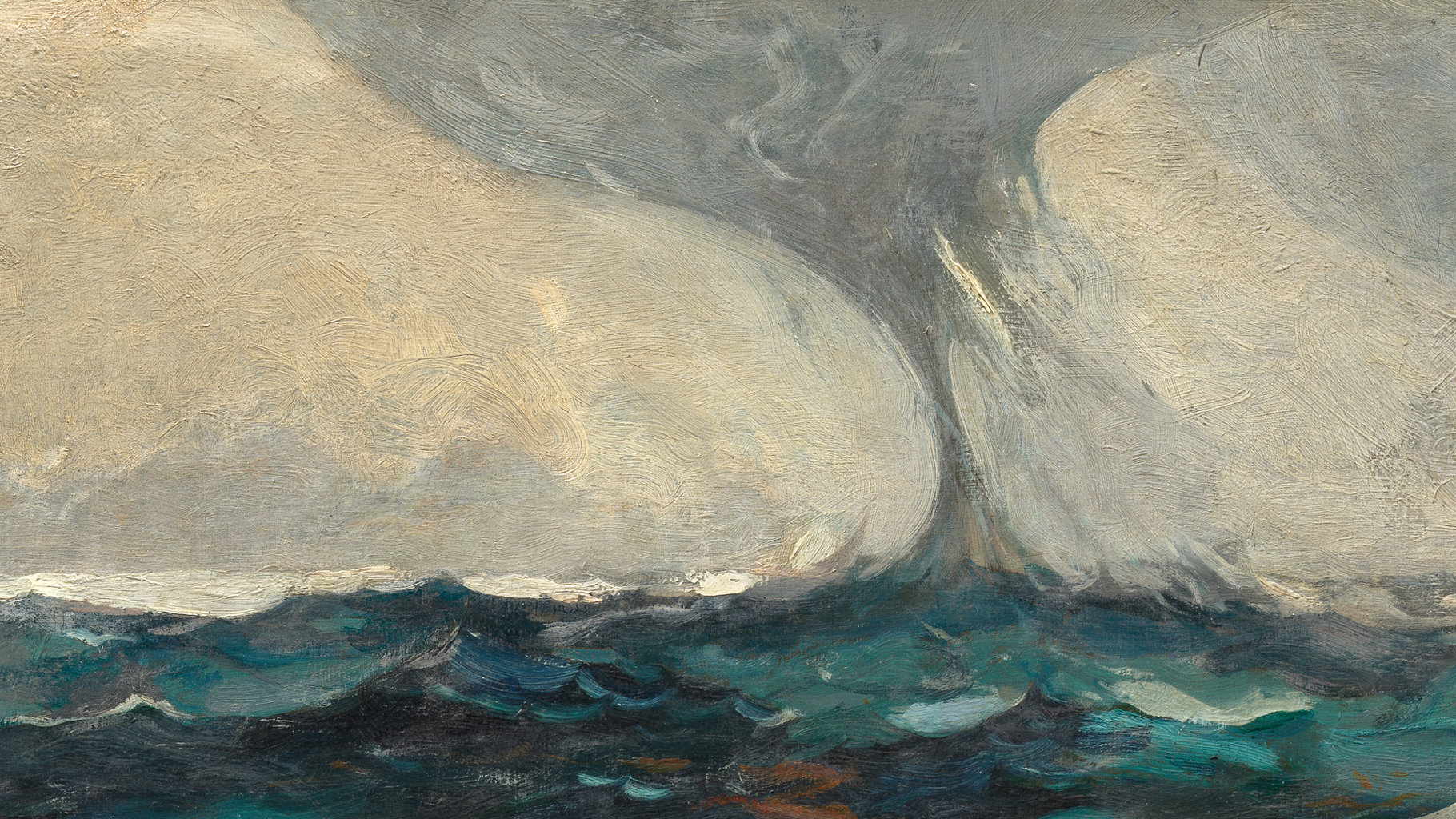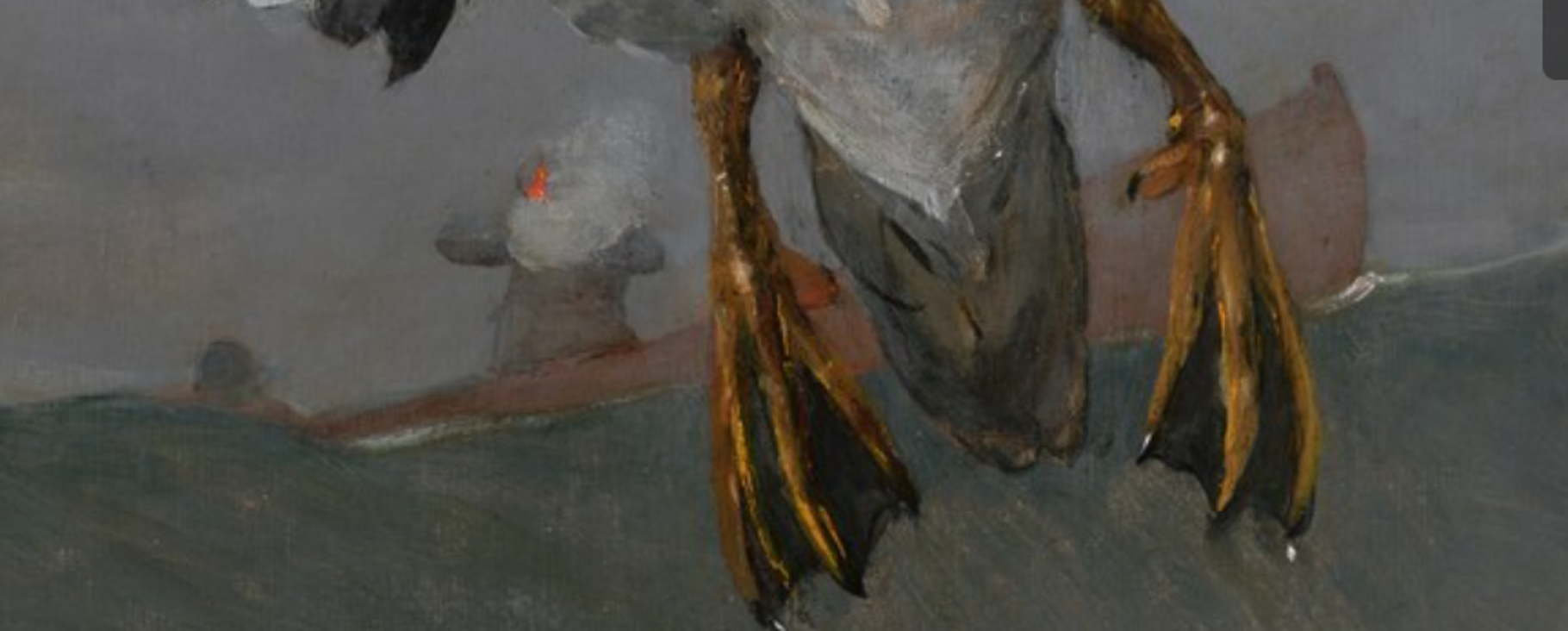
A closer look at three paintings by Homer
'Prisoners from the Front', 'The Gulf Stream' and 'Right and Left'
‘Prisoners from the Front’, 1866
Homer shows a group of muddy, dishevelled Confederate soldiers being held by Brigadier General Francis Channing Barlow following the Battle of Spotsylvania Court House, Virginia, in May 1864.




Close up
Very much like his illustrations for Harper’s Weekly, it’s an image that tells a story. Homer is on the battlefield: to the left, a glimpse of the destruction, tree stumps and churned up fields that continue into the distance; centre, the captured figures and the Brigadier General; and to the right, in the near distance, almost sketched in, troops, horses, flags and weapons.
The muted tones and frank study of the figures in their well-worn uniforms is understated, unglamourous and powerful.
Homer was given a pass that allowed him to sketch at the front (he was able to visit both sides). He visited three times and would have referred to his sketches to create this painting which he completed in his studio after the war had ended.



Close up
Very much like his illustrations for Harper’s Weekly, it’s an image that tells a story. Homer is on the battlefield: to the left, a glimpse of the destruction, tree stumps and churned up fields that continue into the distance; centre, the captured figures and the Brigadier General; and to the right, in the near distance, almost sketched in, troops, horses, flags and weapons.
The muted tones and frank study of the figures in their well-worn uniforms is understated, unglamourous and powerful.
Homer was given a pass that allowed him to sketch at the front (he was able to visit both sides). He visited three times and would have referred to his sketches to create this painting which he completed in his studio after the war had ended.
‘The Gulf Stream’, 1899 reworked by 1906
Homer sketched this image during the first of what were to be many trips to the Caribbean. This is a dramatic sight: a boat lurching on the waves, a stormy sea, the skyline intermittently hidden from view.






Close up
Homer used his sketches as the basis for this oil painting which he painted in 1899 and had revisited by 1906. The feeling of movement created by the pitch of the boat is very like the effect created by boats in earlier works including ‘Breezing up (A Fair Wind)’ of 1873–6 and ‘The Fog Warning’ of 1885.
We are witnessing a life-threatening situation in which a man, alone in an uncontrollable boat, braces himself against choppy waters.
Sharks circle menacingly around the boat and, as if things couldn’t get any worse, there’s a waterspout on the horizon and potential help is way off in the distance.
The Gulf Stream is a strong, warm Atlantic Ocean current that travels up America’s east coast from the south, via the Florida Straits, to Newfoundland’s Grand Banks. Different levels of salt in the waters that make up the current cause its colour to vary and contrast when they meet. To the south, it’s home to tuna and flying fish and we can make out a shoal of flying fish skimming along above the water. Sharks are everywhere in the painting, even visible just below the water’s surface.
Homer wanted people to look at the painting from a specific distance and scrawled instructions on the bottom left of the canvas in tiny painted script, ‘At 12 feet from the picture you can see it.’
Despite Homer’s apparent rather abrupt reply when asked by his New York dealer what the painting was about, ‘You ask me for a full description of my picture of the –‘Gulf Stream’ – I regret very much that I have painted a picture that requires any description’, inevitably people find the broader themes that attracted Homer encapsulated in this painting: nature’s power; the unpredictable sea as an embodiment of this force; and the challenges faced by Black Americans in post-Civil War US.




Close up
Homer used his sketches as the basis for this oil painting which he painted in 1899 and had revisited by 1906. The feeling of movement created by the pitch of the boat is very like the effect created by boats in earlier works including ‘Breezing up (A Fair Wind)’ of 1873–6 and ‘The Fog Warning’ of 1885.
We are witnessing a life-threatening situation in which a man, alone in an uncontrollable boat, braces himself against choppy waters.
Sharks circle menacingly around the boat and, as if things couldn’t get any worse, there’s a waterspout on the horizon and potential help is way off in the distance.
The Gulf Stream is a strong, warm Atlantic Ocean current that travels up America’s east coast from the south, via the Florida Straits, to Newfoundland’s Grand Banks. Different levels of salt in the waters that make up the current cause its colour to vary and contrast when they meet. To the south, it’s home to tuna and flying fish and we can make out a shoal of flying fish skimming along above the water. Sharks are everywhere in the painting, even visible just below the water’s surface.
Homer wanted people to look at the painting from a specific distance and scrawled instructions on the bottom left of the canvas in tiny painted script, ‘At 12 feet from the picture you can see it.’
Despite Homer’s apparent rather abrupt reply when asked by his New York dealer what the painting was about, ‘You ask me for a full description of my picture of the –‘Gulf Stream’ – I regret very much that I have painted a picture that requires any description’, inevitably people find the broader themes that attracted Homer encapsulated in this painting: nature’s power; the unpredictable sea as an embodiment of this force; and the challenges faced by Black Americans in post-Civil War US.
Right and Left, 1909
Nature was important to Homer. He sought out and painted in rural locations. He liked being outdoors and enjoyed outdoor pursuits alongside his brother and friends: fishing, hunting and walking.
This striking painting, a wonderful study of goldeneye ducks, is unusual in that the birds are right in front of us, painted in detail.




Close up
The position of the ducks is uncomfortable. They’ve just been shot in quick succession, as the title tells us, with cartridges from the right and left barrels of a shot gun – not an easy thing to do.
To the left a duck, with wings outstretched, hangs in the air. The look in its eye conveys the animal’s shock and terror as it tries to take flight.
The other duck tumbles out of the sky awkwardly, head-first, the angle reminiscent of ducks strung up by their feet in markets.
The small figures of the hunters are in the distance in a canoe on the horizon, hidden by a cloud of smoke from the gun. The sky is grey and the water rough, the waves nearly obscure the boat.
When we get up close to the painting, we can see a small dash of red paint, blood, near the left-hand duck’s left leg.
Painted a year before Homer’s death, there’s a darkness to this painting, not only in its palette but also in the subject - humankind in conflict with nature, the brevity of life and mortality.


Close up
The position of the ducks is uncomfortable. They’ve just been shot in quick succession, as the title tells us, with cartridges from the right and left barrels of a shot gun – not an easy thing to do.
To the left a duck, with wings outstretched, hangs in the air. The look in its eye conveys the animal’s shock and terror as it tries to take flight.
The other duck tumbles out of the sky awkwardly, head-first, the angle reminiscent of ducks strung up by their feet in markets.
The small figures of the hunters are in the distance in a canoe on the horizon, hidden by a cloud of smoke from the gun. The sky is grey and the water rough, the waves nearly obscure the boat.
When we get up close to the painting, we can see a small dash of red paint, blood, near the left-hand duck’s left leg.
Painted a year before Homer’s death, there’s a darkness to this painting, not only in its palette but also in the subject - humankind in conflict with nature, the brevity of life and mortality.


